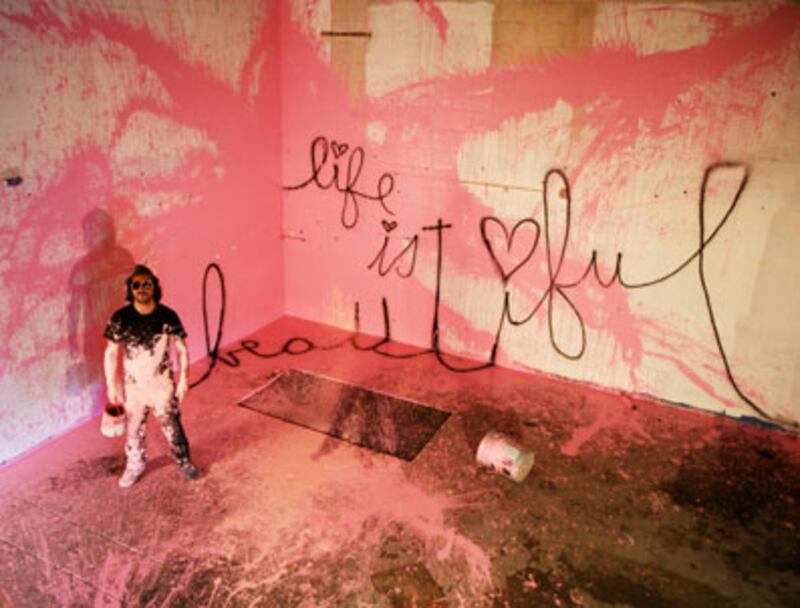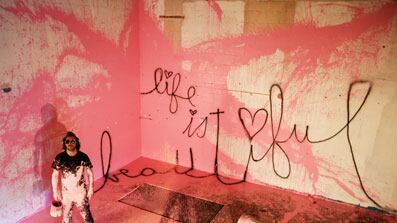The art world establishment stayed away in droves from the opening of Mr. Brainwash’s show, Icons, in New York’s West Village on February 11. And this would seem to be just the way the artist likes it.
Thierry Guetta—his real name—is French-born Los Angeleno who began as a documentary filmmaker, working closely with street artists, including the infamous Banksy. Over time, he became a street artist himself: the splendidly named Mr. Brainwash. MBW’s sheer determination made him an increasingly visible presence. And 2008’s Life Is Beautiful, a massive show in the old CBS building on Sunset Boulevard made him a star.
Click Image To View Our Gallery Of Mr. Brainwash’s “Icons”

The following year Mr. Brainwash was commissioned to do the cover of Madonna’s CD Celebration, along with art for her DVDs and singles, fifteen pieces in all. And this year he was a central figure in Exit Through the Gift Shop, a film by Banksy (which I have not seen) that deals with street art, celebrity, marketing and especially Guetta and himself, and which was a hit at Sundance.
Icons is the attempt of Mr. Brainwash, who represents himself, to storm New York.
He likes the challenge. A couple of days before the opening I had asked him how closely he followed the art world? For instance, does he read art magazines?
“Never,” the 44-year-old artist said, unblinking eyes dimly visible through dark aviators.
Does he go to exhibitions?
“ Nevaire!” His rising voice had taken on Inspector Clouseau inflections, surprising for a fulltime Southern Californian. “I don’t look at people, what they do. I am completely outside of the art world. I know a couple of names—Damien Hirst, Jeff Koons. But I don’t know anything. I have my own little world.”
Mr. Brainwash’s little world right now included this show of 200 or so Neo-Post-Pop paintings, mostly portraits, and more than a dozen sculptures spread over the 15,000-square foot ground floor space of this building which is also occupied by the blue-chip gallery, Sperone Westwater, and the Bohen Foundation. One piece in the show, a portrait of Jim Morrison constructed from broken vinyl records, had already sold for $100,000. Others were being offered for three times that.
That was one paradox. Another was that the introduction of this self-proclaimed outsider artist to Manhattan was being orchestrated by the sleek publicity machine that is Nadine Johnson. So, given the serpentine thinking natural to the worlds of art and celebrity, one shouldn’t be surprised at the rumors that the Mr. Brainwash phenomenon was the creation of Banksy, whose face has never actually been seen. Indeed, some have speculated that Mr. Brainwash is Banksy.
Absolutely not. Thierry Guetta’ backstory is too eccentrically, even touchingly, plausible. He had lived in LA for many years with his family and he says that it was the deaths of his mother and father that inspired him to videotape his entire life, 24/7, much as Josh Harris was doing concurrently in New York. But whereas Harris was working behind closed doors, Guetta was out on the streets, with artists becoming increasingly part of his universe.
Some prominent street artists he filmed include the agit-Pop transformer of billboards, Ron English, who was at the West 13th Street opening; Invader, who is his cousin, and who had shown pieces made from dissected Rubik’s cubes a couple of weeks before at an art party in the former Tower Records; and Shepard Fairey, best known for his Obama image, Hope. Fairey has said that he was impressed by MBW’s willingness to hoist his camera to the most dangerous vantage points, by his sheer obsessiveness. Fairey has also said “I want to hug him one second and smack him the next.”
This street art energy amped up after Banksy came to LA in 2006. Guetta, who was introduced by Shepard Fairey, became Banksy’s accomplice/assistant and filmed him during the lightning strikes when he would make a piece, most notably as he installed a blow-up Gitmo doll alongside the rides at Disneyland. But Guetta then edited the footage afforded by this unique access into a film which has been described as opaque to the point of unwatchable. In one of his sub-Comandante Zero-type communiqués, Banksy described Guetta as “maybe just someone with mental problems who happened to have a camera.”
The work in “Icons” features a wall of artist portraits. These include Takashi Murakami, Jasper Johns, Francis Bacon, Roy Lichtenstein, Jeff Koons, and two identical Basquiats. Banksy is represented by an image he has himself supplied, which looks like a character from Planet of the Apes run through a computer redesign program. And at either end of the wall, wittily, are portraits of Magritte and Norman Rockwell, each wearing a truly ridiculous hat. “Norman Rockwell is the one who really gets close to me,” MBW told me. That these are rather more than the “couple of names” he had dropped didn’t surprise. Self-presentation has become a basic art world tool.
Other icons, like the Jim Morrison portrait, are made from fragments of vinyl record. I noted that it looked like he had used a special tool.
“These are my secrets. When you go to a good restaurant the chef is not going to give you his pepper sauce,” Mr. Brainwash said. This was endearing.
A Banksyesque stencil of Einstein carries a sign bearing the most unBanksyesque: message LOVE IS THE ANSWER. Other portraits come with references. The Rolling Stones are backed up a frieze of Warhol soup cans and Yves Saint Laurent is shown against a backdrop of Damien Hirst spots which have themselves become a sort of abstract Neo-Pop.
And there are portraits of Unknown Celebrities, such as the creators of YouTube and MySpace. “A lot of people tell me, ‘What are you doing? Nobody knows them,’” Mr. Brainwash said. “I say, ‘These young kids here, they changed the world.’”
Sculptures on view include several giant spray cans; one whose central image derives from the Beatles crossing Abbey Road, remade from piles of vinyl records; and a life-size horse, prancey as a de Chirico, fabricated from rubber tires.
There was also a Warholesque portrait of Kate Moss. Banksy has, of course, represented Moss after the manner of Warhol’s Marilyn. And Warhol’s Marilyn, which has taken on a significance as a cultural marker far beyond itself, is the dominant image in Mr Brainwash’s show. But he has been careful. Rather more careful than Warhol himself, in fact. I asked—only partly a joke—whether he had heard from the Warhol Foundation?
“No. For what?” MBW said. “Whatever I did, it’s all my creation. It has nothing to do with Warhol. They make sure with the Warhol Foundation that we couldn’t use it So I had to come up with two different pictures—what I create and what’s Warhol. It’s completely, completely different.” He added “It’s not some little people that are waiting to get sued. In the end I come up with my own thing.”
So here we see Obama-as-Marilyn, Damien Hirst-as-Marilyn, Marilyn stacked next to Marilyn, including the Maddona-as-Marilyn, which was the Celebration cover, and—but of course—Andy Warhol-as-Marilyn.
Mr Brainwash’s works lack both Banksy’s singular precision and the political edge, the in-your-face attitude that also characterizes such street artists as the UK’s Mutoid Waste Company. But he does have politics, of a sort. Of the tire horse he notes, “I work with tires because that’s the only thing you can’t recycle, the only thing you can’t get rid of. You cannot burn them, you cannot bury them. I want to come up with the idea that art can be doing something to save the planet.” This retro ‘60s side to Mr. Brainwash is clearly genuine.
Some images are strong. Many are sloppily melodramatic and the show seems thrown at you unedited. And—this is his Euro-origins, I think—Mr. Brainwash’s take on Americana can be as off as Paris, Texas or Zabriskie Point although it’s a great deal more more goofily enthusiastic. It seems to the point that one of Thierry Guetta’s pre-Mr. Brainwash pieces was a bronze statue of Charlie Chaplin.
And the obsessiveness is real and all-embracing. A friend had heard that Mr. Brainwash had staked everything he had on this show. He asked him whether this was true.
“Yes,” Mr. Brainwash said.
I kind of want to believe that.
Plus: Check out Art Beast for galleries, interviews with artists, and photos from the hottest parties.
Anthony Haden-Guest is the news editor of Charles Saatchi’s online magazine.





